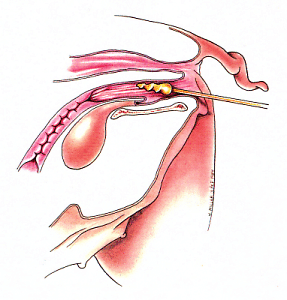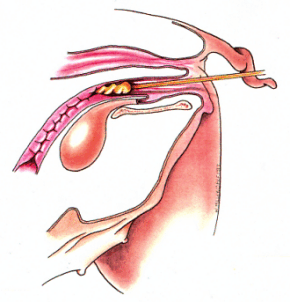SWINE INSEMINATION
By: Wayne L. Singleton, Purdue University
Artificial insemination (AI) is a tool that can be used by heritage swine breeders to introduce new genetics into their herd with reduced cost and health risks compared to introducing live animals. Timing of insemination is critical, and females should be inseminated at the onset of standing heat and again about 24 hours later. Best results are expected when the semen dose is less than 48 hours old, contains about 2.5 billion viable cells and has been stored at 17-18 °C (60-64 °F). Either spiral or foam tipped insemination catheters are available from specialty suppliers. Some AI suppliers offer smaller catheters designed for gilts, and these may be more desirable when inseminating sows of smaller heritage breeds.
The following steps describe the insemination process. (Another process is available, intrauterine insemination (also called post-cervical AI), but is appropriate only if some training is available, and that procedure is not discussed in this guide.)
Step 1:
 Identify the female in standing heat. Provide face-to-face, fence-line contact with a mature boar. If boars are not present on the farm, consider using a washcloth with boar saliva if available. Inseminating without a boar is also possible, though often reduced fertility is expected. If the sow is in standing estrus she will stand solid to be inseminated. Without a boar present there is a little subjectivity, and the breeder should be prepared to follow the female with the insemination catheter. If necessary, clean the vulva with a soft paper towel.
Identify the female in standing heat. Provide face-to-face, fence-line contact with a mature boar. If boars are not present on the farm, consider using a washcloth with boar saliva if available. Inseminating without a boar is also possible, though often reduced fertility is expected. If the sow is in standing estrus she will stand solid to be inseminated. Without a boar present there is a little subjectivity, and the breeder should be prepared to follow the female with the insemination catheter. If necessary, clean the vulva with a soft paper towel.
- Lubricate the catheter tip with a small amount of sterile, water soluble, non-bactericidal, non-spermicidal lubricant. These are specifically designed to be effective lubricants and to not harm sperm survival, and you can ask the semen or catheter supplier what brand they carry. Standing on the left side of the female, facing backwards, use left hand to spread the vulva lips, insert the catheter about 3 to 4 inches.
- Reposition yourself to the rear of the female.
- Position the catheter at a 20 to 30 degree angle with the tip pointed upwards. Gently push forward and backward until the tip is about 4 to 6 inches forward. (This will avoid entering the urethral [bladder] opening).
 Step 2:
Step 2:
Position the catheter more horizontally and continue to gently move it forward until resistance is felt. This should indicate that the tip is at the cervical opening.
Gently rotate the catheter counter-clockwise as the cervix is entered. Rotation is not necessary with foam-tipped catheters. Obtain a firm lock which is indicated when the catheter feels tight and will spring back about 1/4 turn. Do not force it too much.
 Step 3:
Step 3:
Connect the semen bottle/tube to the shaft of the catheter and hold in an upright position. Initiate semen flow by application of gentle pressure on the bottle/tube. Gentle, alternating movement of the catheter may enhance flow of semen. Stimulate the female via back pressure and rubbing the underline and flank area. Be patient, some females will “take” the semen with little or no pressure being applied to the bottle/tube, while others may require alternating slight pressure on the bottle/tube. Allow 3 to 5 minutes, minimum, per female. Some require more time than others. DO NOT RUSH.
When completed, gently rotate the catheter in a clockwise fashion and remove. The sow should be allowed to relax at least 30 minutes. Properly dispose of the equipment (i.e., they are plastic so non-biodegradable and should go to a sanitary landfill). DO NOT REUSE CATHETER. Record and score the mating.
